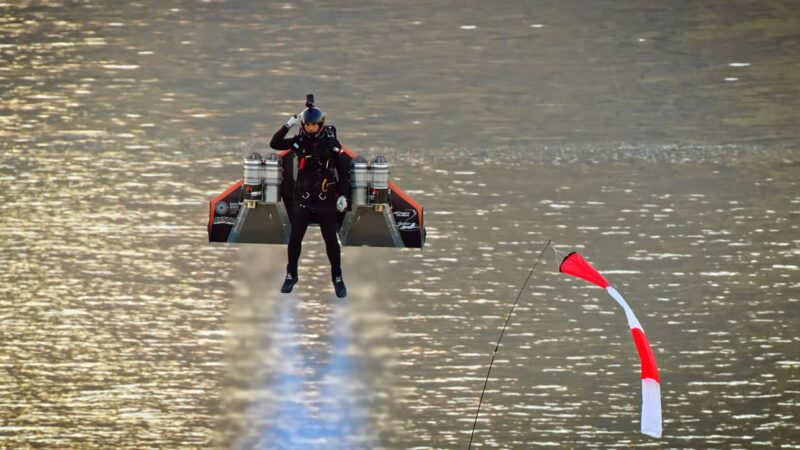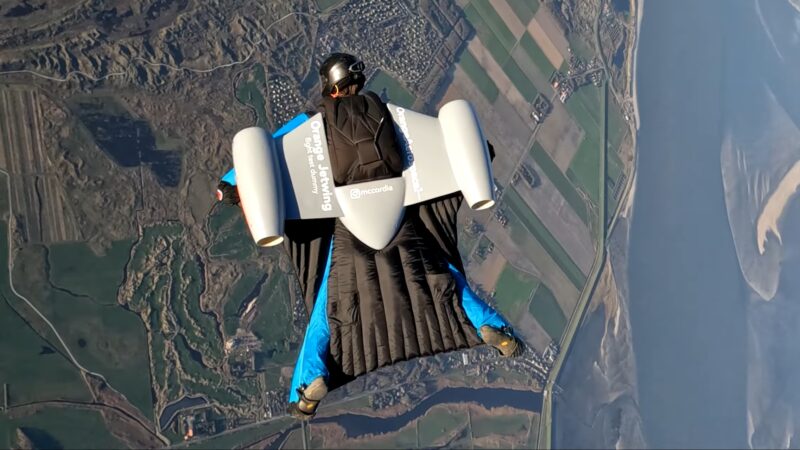Let’s face it: we’re all still waiting for our jetpacks. For everyone who isn’t instead obsessed with Back to the Future hoverboards, the jetpack has remained the single benchmark of futuristic technology that mankind has only barely been able to crack. The good news is that we are getting closer. Over the past few years, various attempts have been made, from initial prototypes to devices that can aid emergency service workers or even jetpack-style devices that can help people to run faster. In this blog post, we’ll delve deep into the world of jet-powered wingsuits and how they’re bringing us closer to the full jetpack experience.
The Evolution of Flight Dreams
The dream of human flight has been a part of our collective consciousness for centuries. From the mythological tales of Icarus to the more recent superhero fantasies, the idea of soaring through the skies has always captivated us.
The Icarus Dream
The ancient Greek myth of Icarus, who flew too close to the sun with wings made of feathers and wax, serves as a cautionary tale about the dangers of overreaching. However, it also highlights humanity’s age-old desire to break free from the confines of the earth and soar among the clouds.
Modern Day Superheroes
Fast forward to the 20th and 21st centuries, and the dream of flight has been kept alive through our favorite superheroes. Characters like Superman, Iron Man, and Falcon have only intensified our yearning for personal flight. Their stories, while fictional, represent the pinnacle of human aspiration in the realm of flight.
The Reality of Jetpacks

While comic books and movies have teased us with the idea of personal flight, the reality has been much more elusive. There have been numerous attempts to create a functional jetpack, but most have been met with limited success.
Initial Prototypes
The early days of jetpack development were filled with excitement and hope. Prototypes were built with the promise of revolutionizing personal transportation. However, these early models were plagued with issues like limited flight time, safety concerns, and exorbitant costs.
Modern Day Innovations
In recent years, there have been significant advancements in jetpack technology. Companies and inventors around the world are working tirelessly to make the dream of personal flight a reality. From jetpacks that assist emergency workers to those designed for recreational use, the future of personal flight seems brighter than ever.
Jarno Cordia’s Jet-Powered Wingsuit

Dutch athlete and extreme sports enthusiast Jarno Cordia might just have the answer to our jetpack dreams. His innovative approach combines the thrill of wingsuit flying with the power of jet propulsion.
The Design and Functionality
Cordia’s wingsuit is not just any ordinary wingsuit. It’s equipped with jet engines strapped to his back and legs, allowing him to glide through the air with incredible efficiency. This design is reminiscent of Tony Stark’s Iron Man suit, giving the wearer a sense of power and control while in flight.
- Key Features:
- Jet engines on the back and legs
- Enhanced gliding capabilities
- Increased flight time compared to traditional wingsuits
The Flight Experience
The jet-powered wingsuit offers a unique flight experience. While it requires an initial launch from a high vantage point, such as a hot air balloon, once airborne, the thrusters provide enough power to maintain or even gain altitude. This is a significant advancement from traditional wingsuits, which rely solely on the wearer’s body shape and the wind to glide.
The Challenges of Jet-Powered Flight

As with any groundbreaking technology, there are challenges and obstacles to overcome. The journey to perfecting the jet-powered wingsuit has been filled with trials, errors, and lessons learned.
Safety Concerns
The primary concern with any flight device is safety. Jet engines produce intense heat, and there’s always a risk of malfunction. Ensuring that the engines don’t cause harm to the wearer or result in uncontrolled movements is paramount.
- Potential Risks:
- Engine malfunction leading to uncontrolled movements
- Risk of burns from the intense heat of the engines
- Challenges in safe landing due to increased speed and altitude
Technological Limitations
While the jet-powered wingsuit represents a significant advancement, there are still technological hurdles to overcome. Battery life, weight distribution, and fuel efficiency are just a few of the issues that innovators like Cordia face.
The Future of Personal Flight

The jet-powered wingsuit is just the beginning. As technology continues to advance, we can expect even more incredible innovations in the realm of personal flight.
Eco-Friendly Propulsion
With the growing emphasis on sustainability, future jetpacks and wingsuits might utilize eco-friendly propulsion methods. Innovators are already exploring electric jet engines and other green technologies to power personal flight devices.
- Advantages of Eco-Friendly Propulsion:
- Reduced carbon footprint
- Quieter flight experience
- Potential for longer flight durations with renewable energy sources
Urban Mobility and Jetpack Commuting
Imagine a world where you can strap on your jetpack and fly to work, bypassing traffic and reducing your commute time significantly. As urban areas become more congested, the idea of jetpack commuting becomes more appealing.
Final Words
In conclusion, while we may not have full-fledged jetpacks just yet, innovations like Jarno Cordia’s jet-powered wingsuit are bringing us one step closer to realizing our dreams of personal flight. The future of flight is exciting, and with continued advancements in technology, the sky is truly the limit.













